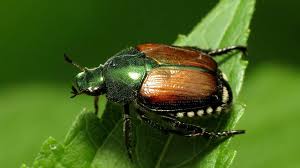Japanese beetles, originally from Asia, have become a familiar summertime pest across Illinois since their introduction to the United States in 1916. These invasive insects are notorious for their voracious appetite, particularly targeting over 300 different plant species found in both ornamental gardens and agricultural settings throughout the state.
From early June in Southern Illinois to the onset of July in Northern Illinois, Japanese beetles swarm gardens, feeding on leaves and potentially decimating plants within a short period. Their ability to fly up to 30 miles in a day and lay up to 500 eggs highlights their rapid reproductive capacity, posing a significant challenge to gardeners and farmers alike.
The impact of Japanese beetles extends beyond mere annoyance, affecting a wide range of plants cherished by Illinois residents. Fruit trees like apple, cherry, and peach, along with berries, roses, and various ornamental plants, are among their favorite targets. Their attraction to damaged plants further exacerbates the problem, making control efforts crucial during their approximately six-week lifecycle.
Gardeners seeking to protect their plants from Japanese beetles face several strategies, each with its own effectiveness and drawbacks. Hand-picking beetles and drowning them in soapy water offers a non-toxic approach, albeit labor-intensive. Alternatively, Japanese beetle traps can attract large numbers of beetles but might inadvertently increase the overall population in the vicinity.
The use of pesticides is another option, though it carries the risk of harming beneficial insects alongside the targeted pests. For more delicate plants, insect netting provides a physical barrier against beetles without resorting to chemical treatments.
Also Read:
- Early Emergence of 17-Year Cicadas in Chicago Marks a Rare Natural Event
- Last Chance for Anglers: Brood XIII Cicadas Create Unique Fishing Opportunities
In conclusion, managing Japanese beetles in Illinois demands a proactive approach that balances effective control measures with environmental considerations. As these pests continue to thrive across the state, staying informed about their behavior and implementing appropriate management practices remains essential for preserving Illinois’ green spaces and agricultural productivity.





